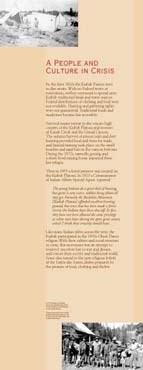
By the late 1800s the Kaibab Paiutes were in dire straits. With no Federal treaty or reservation, settlers continued to spread onto Kaibab traditional lands and water sources. Federal distributions of clothing and food were not available. Hunting and gathering rights were not guaranteed. Traditional foods and medicines became less accessible. Survival meant retreat to the remote high country of the Kaibab Plateau and recesses of Kanab Creek and the Grand Canyon. The autumn harvest of pinyon nuts and deer hunting provided food and items for trade, and limited farming took place on the small beaches and sandbars in the canyon bottoms. During the 1870s, sawmills, grazing and a short-lived mining boom impacted these last refuges. Then in 1893 a forest preserve was created on the Kaibab Plateau. In 1903 a Commissioner of Indian Affairs Special Agent reported: The young Indians do a great deal of hunting, but game is very scarce, rabbits being about all they get. Formerly the Buckskin Mountain [Kaibab Plateau] afforded excellent hunting ground, but since that has been made a forest reserve the Indians have been shut off. In fact, they have not been allowed the same privilege as white men have during the open game season, which I think they certainly should have. Like many Indian tribes across the west, the Kaibab participated in the 1890s Ghost Dance religion. With their culture and social structure in crisis, this movement was an attempt to resurrect ancestors lost to war and disease, and restore their society and traditional world. Some also turned to the new religious beliefs of the Latter-day Saints, drawn primarily by the promise of food, clothing and shelter. | ||
|
| ||
Last updated: March 31, 2012
